The World's Fastest Human
1 In the summer of 1919, Quincy and Jesse Owens rested in the shade of an oak tree near the farmhouse
where they lived. The cool shade was one of their favorite places to linger during the hot summer days. In the
distance they could see their father, a sharecropper, working in the fields under the Alabama sun.
2 Quincy, who was the oldest of the eight Owens children, pulled three marbles from his pocket and tossed
them onto the ground. He drew a circle in the dirt and placed the largest marble in the center. Then, while
Quincy began practicing, Jesse climbed up to sit on his favorite branch.
3 A few minutes later their neighbor Sarah joined them. “Hi, guys!” she said. She took two marbles from her
dress pocket and sat next to Quincy.
4 “Hi, Sarah,” the boys mumbled. A gentle breeze rustled the leaves on the tree. Quincy stopped shooting
marbles and leaned against the tree’s trunk. He closed his eyes and smiled.
5 Sarah said, “We always play marbles. Let’s think of something else to do.”
6 Jesse jumped to the ground. “I know! I'll race you, Sarah,” he said. “I'll race you to the willow tree and back.”
7 “You’re only six years old!” said Sarah. “Besides that, I’m as fast as the wind. I can even run faster than my
cousins, who are fourteen!”
8 “I’ll tell you what,” Jesse said, continuing as though he hadn’t heard her. “If you beat me, I'll give you my
kaleidoscope.”
9 With that, Sarah quickly jumped up and drew a starting line in the dirt a few yards away. “Quincy,” she said,
“you count to three. Come on, Jesse. I can’t wait to play with my new kaleidoscope. Let’s start running on three.”
10 Quincy got up and stood next to the starting line. In a fatherly tone he said, “Jesse, just do your best.” Then
he began counting, “One . . . two . . . THREE!”
11 A cloud of dust rose behind the two children as they took off. Sarah quickly pulled ahead of Jesse. She
looked over her shoulder and smiled at him, but he didn’t even see her. He looked straight ahead at the willow
tree and focused on moving his arms and legs in perfect rhythm. Three minutes later, Sarah tagged the willow
tree and spun around to complete the return trip. She was startled to see Jesse right behind her.
12 Jesse tagged the tree and dashed past Sarah. He heard Quincy shout, “C’mon Jesse, you’re ahead. Run
faster! Run faster!” Seconds later, Jesse crossed the finish line,—ahead of Sarah. He had won the race!
13 Quincy danced with excitement. “He won! He won!” he shouted as Sarah crossed the finish line. “Jesse
beat you! My little brother beat you!”
14 Sarah placed her hands on her knees while she caught her breath. “He surely did just that!” she said with a
smile. Then she put her arm around Jesse, who was beaming. “You really run like a pro!” she said.
15 Several years later, Sarah became a student at Missouri State University. She continued to run races as
a member of the track team, but she always remembered her race with Jesse. One day, as she walked into a
building on campus, she noticed a newspaper stand. The headlines on the newspaper caught her attention:
World’s Fastest Human: Jesse Owens Wins Four Gold Medals in Berlin Olympics.
16 “That’s my Jesse!” she thought fondly.
Note: It was in the year 1936 that Jesse Owens won four gold medals at the Olympic Games in Berlin, Germany.
CSR0P120
The author makes the events of the passage
seem more realistic by
A describing the Owens home in careful detail.
B supplying the conversation that might have
taken place.
C naming all seven of Jesse Owens’ sisters and
brothers.
D telling the name of the town where the events
took place.
Results


